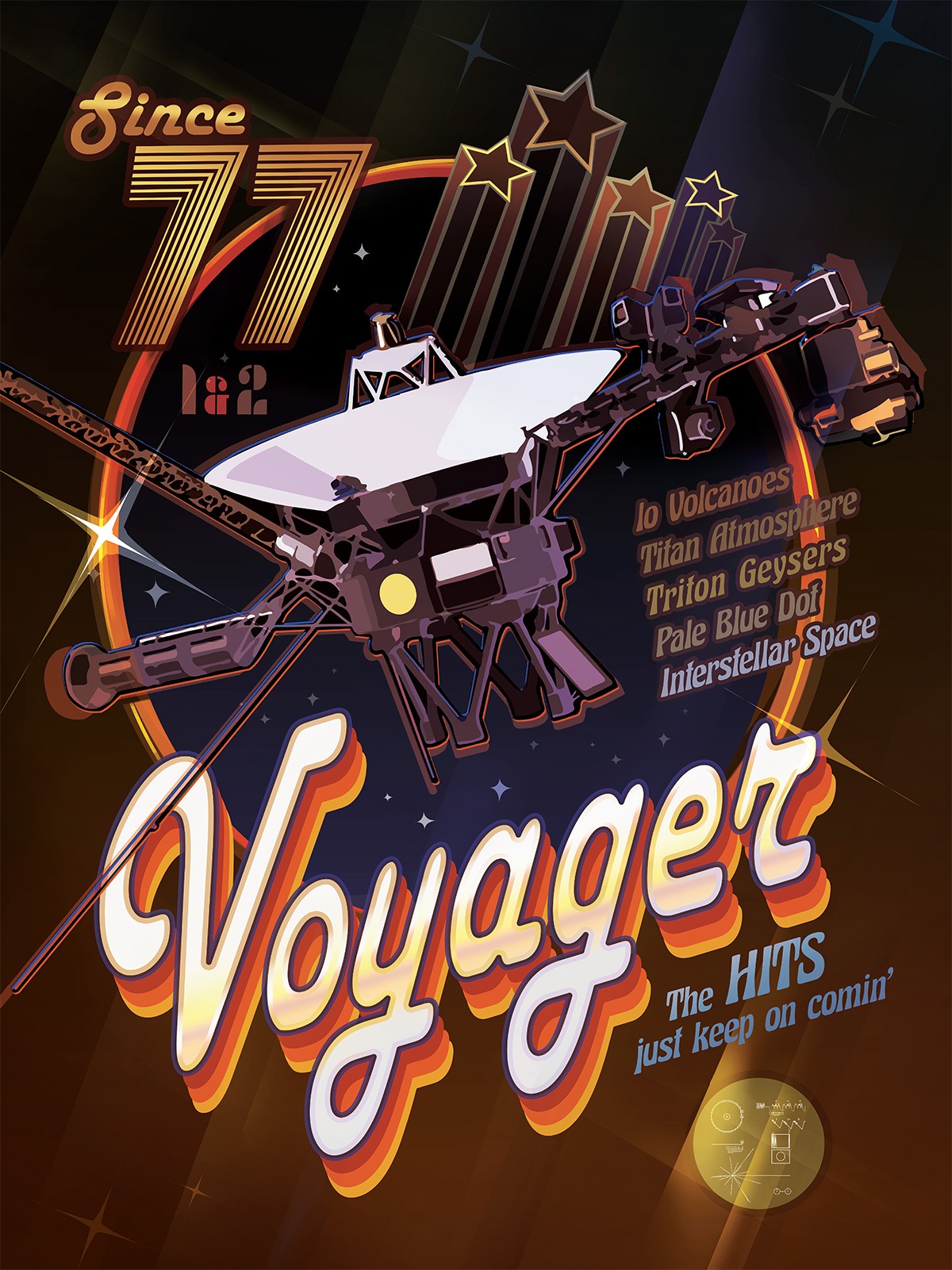Image: The Voyagers Rock On poster (available to download here)
Credit: NASA/JPL-Caltech
September 44 years ago was a very exciting, busy and, no doubt, nerve-wracking time at NASA. At that time the Space Agency had just launched the twin spacecraft, Voyager 1 and Voyager 2, to the yet unexplored outer regions of the Solar System. Voyager 2 – confusingly enough – was launched first. The spacecraft took off from Cape Canaveral on August 20th, 1977. 16 days later, on September 5th, its twin, Voyager 1, left the Earth too. Their missions – to Jupiter, Saturn and beyond – turned out to be a great success. Both yielded an array of remarkable, groundbreaking and unexpected discoveries.
Today, 44 years (and counting!) after the launch, both spacecraft remain active and healthy and regularly call home to say hello. At a distance of over ten billion miles away from the Earth, the twins are now the farthest man-made objects. Moreover, they are so far the only spacecraft that have reached interstellar space.
Let’s talk about this arguably the most ambitious mission ever launched: its achievements, cultural impact and…well, future!
Once-in-a-175-years opportunity!
It all started back in 1964, when Gary Flandro, a then-grad student at Caltech, was given a task to find an optimum trajectory for a future mission to visit the two gas giants, Jupiter and Saturn. Flandro did his job very well. Too well even, for he discovered that in just over 10 years not 2, but all 4 gas planets will align, providing a unique opportunity for a spacecraft to visit them all in one go and save decades in travel time!
The race to develop, test and launch the technology for the journey that would become known as the Grand Tour was on!
Jupiter, Saturn and…Titan?
Originally, the main targets of the Voyager missions were the two closest giants, Jupiter and Saturn and their systems, including – for Voyager 1 – Saturn’s moon Titan. Engineers discussed the possibility for Voyager 2 to visit Uranus and Neptune too, but Titan remained their priority. The flyby of Titan was considered so important that if Voyager 1 (back then it was referred to as JST, or Jupiter-Saturn-Titan mission) was to fail to execute a Titan flyby, then Voyager 2 (referred to as JSX mission) was to go to Titan instead Uranus and Neptune.
Luckily, the back-up mission was not necessary. Voyager 1 successfully explored Titan and Voyager 2 got the green light to continue with its Grand Tour. Voyager 2’s extended mission to the ice giants gave us the first [and, to date, the only] glimpse of these bizarre worlds.
When all the targets were analyzed and photographed as best as the short encounters allowed, the Voyagers continued their epic journeys to the outer edge of the Solar System. Eventually both – first Voyager 1 in 2012, then Voyager 2 in 2018 – reached interstellar space!
Major accomplishments
Before the Voyagers we had only a vague understanding of what’s going on in the outer Solar System. The twin probes have completely revolutionized* our understanding of the big planets and their systems. But what’s more, they continue to provide insights into the structure of interstellar space today.
*You will find a great overview of the spacecrafts’ many accomplishments here
Among our favourite Voyagers’ findings are active volcanoes on Jupiter’s moon Io, geysers on Neptune’s moon Triton and lightning on Jupiter. The spacecraft also determined where the ‘edge’ of the heliosphere is and made the first in-situ measurements of the interstellar space. Impressive!
What do YOU think is the most significant Voyagers discovery and why? Let us know in the comments below!
Message from Earth
The Voyagers are not just planetary explorers, they are Earth’s ambassadors too. Each spacecraft carries the Golden Record – a gold-plated disk containing pictures, music, sounds of the Earth and even spoken greetings in 55 languages! Should either of the twins ever encounter an alien civilization, our galactic neighbours will be able to find out who we are and where we come from.
Future of the Voyagers
It sounds almost unbelievable, but many of the Voyagers instruments still work today. Others, sadly, have been switched off. With each passing year the spacecraft have less and less energy left. Soon the engineers will have to make hard decisions about which instruments to keep and which – to shut down. We will probably stop receiving science data from the robotic explorers by 2025. Both Voyagers will go completely silent around their 50th anniversary. Although we will not hear from the probes after that, the two will continue to orbit around the centre of the Milky Way.
More information
To find out more about Voyager 1 and Voyager 2,
- check mission status (current distance, velocity etc) on NASA Voyager website
- learn how scientists communicate with the Voyagers and other robotic space explorers in our blog post How to talk to a far-away spacecraft: Deep Space Network
- watch Voyager mission 40th anniversary presentation by NASA JPL
- visit our inflatable Star Dome
Author: Irina Vladimirova
Irina Vladimorova is a presenter at WonderDome Planetarium and a regular contributor to WonderDome Astronomy Blog. She holds a degree in Astrophysics and a special place in her heart for planetary science.

